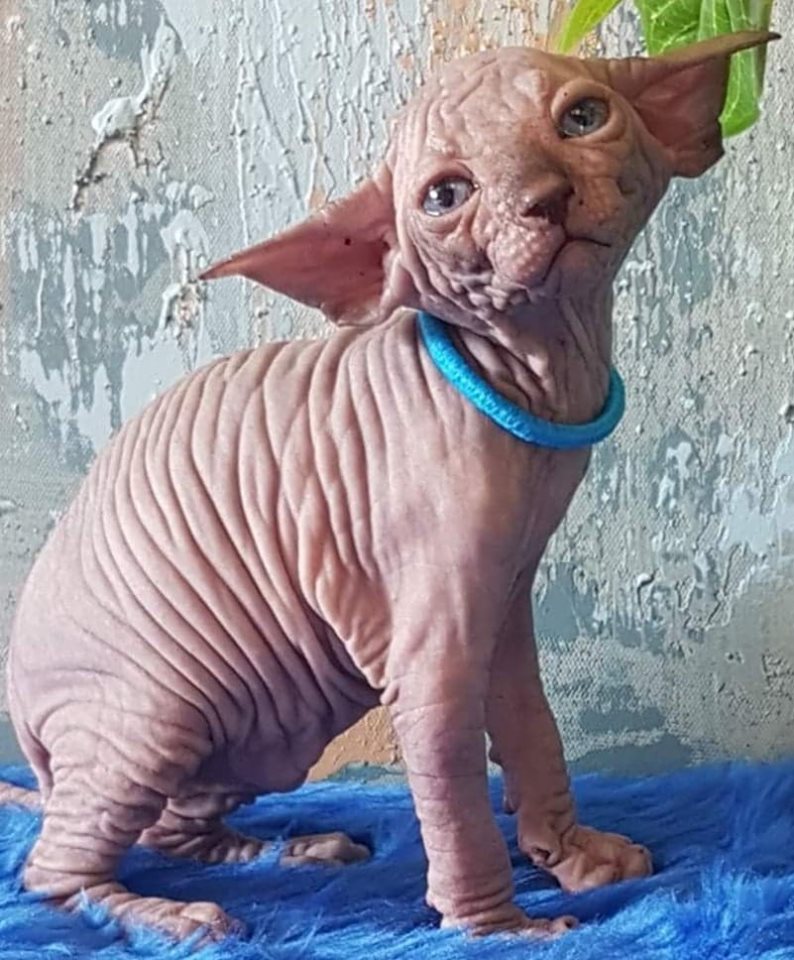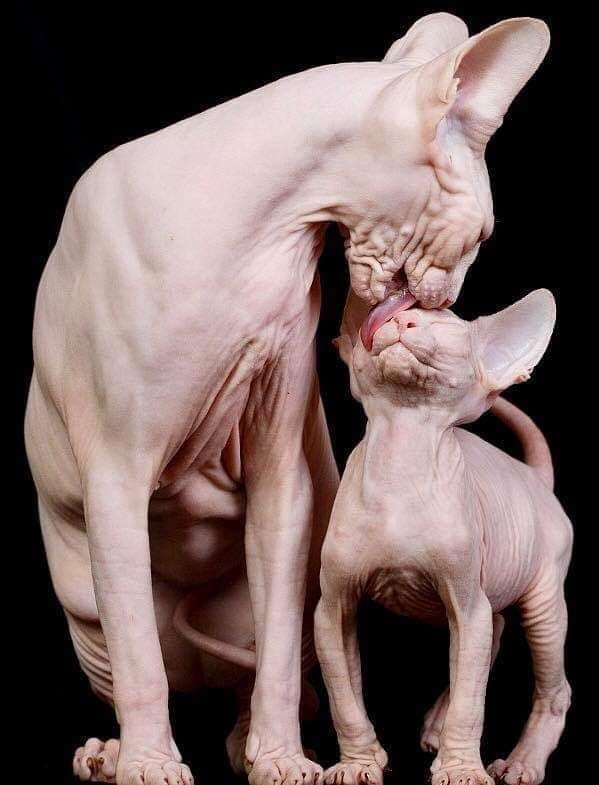About the Sphynx Breed
The Sphynx cat is a breed of cat known for its lack of coat (fur). Hairlessness in cats is a naturally occurring genetic mutation; however, the Sphynx cat, as a breed, was developed through selective breeding, starting in the 1960s.
The skin should have the texture of chamois leather, as it has fine hairs, or the cat may be completely hairless. Whiskers may be present, either whole or broken, or may be totally absent. The cats have a narrow, long head, and webbed feet. Their skin is the color that their fur would be, and all the usual cat markings (solid, point, van, tabby, tortie, etc.) may be found on the Sphynx cat’s skin.
Because they have no fur they lose more body heat than coated cats; this makes them warm to the touch, and prone to finding warm places.

Sphynx Breed Standards
Wedge-shaped heads with prominent cheekbones
Large, lemon-shaped eyes
Very large ears with no hair on inside, but soft down on outside base
Well-muscled, powerful neck of medium length
Medium length torso, barrel-chested, and full, round abdomen, sometimes called a pot belly
Paw pads thicker than other cats, giving the appearance of walking on cushions
Whiplike, tapering tail from body to tip, (sometimes with fur all over tail or a puff of fur on the tip, like a lion)
Muscular body

Sphynx Behaviour
History of the breed
The contemporary breed of Sphynx cat, also known as the Canadian Sphynx, is distinct from the Russian hairless cat breeds, like Peterbald and Donskoy.
Although hairless cats have been reported throughout history, breeders in Europe have been working on the Sphynx breed since the early 1960s. Two different sets of hairless felines discovered in North America in the 1970s provided the foundation cats for what was shaped into the existing Sphynx breed.
The current American and European Sphynx breed is descended from two lines of natural mutations:
Dermis and Epidermis (1975) barn cats from the Pearson family of Wadena, Minnesota
Bambi, Punkie, and Paloma (1978) stray cats found in Toronto, Ontario, Canada, and raised by Shirley Smith
Genetics & Breeding
Other hairless breeds might have body shapes or temperaments that differ from those described above. There are, for example, new hairless breeds, including the Don Sphynx and the Peterbald from Russia, which arose from their own spontaneous gene mutations. The standard for the Sphynx differs between cat associations such as The International Cat Association (TICA), Fédération Internationale Féline (FIFE) and Cat Fanciers’ Association (CFA).
Breeding
In 2010, DNA analysis confirmed that Sphynx hairlessness was produced by a different allele of the same gene that produces the short curly hair of the Devon Rex (termed the “re” allele), with the Sphynx’s allele being incompletely dominant over the Devon allele and both being recessive to the wild type. The Sphynx’s allele is termed “hr”, for hairless. The only allowable outcross breeds in the CFA are now the American Shorthair and Domestic Shorthair. Other associations may vary, and the Russian Blue is a permitted outcross in the Governing Council of the Cat Fancy (GCCF). In Europe, mainly the Devon Rex has been used for outcrosses.
Genetics
The Sphynx’s hairlessness is produced by a mutation in the same gene that produces the short curly coat of the Devon Rex. Moreover, it was found that the curly coat of Selkirk Rex cats is also associated with this gene.
The gene encodes keratin 71 (KRT71) and is responsible for the keratinization of the hair follicle. The Sphynx’s mutation leads to a complete loss of function where the structure of the hair is damaged so that i.e. the hair can be formed but is easily dislodged. In the Devon Rex mutation, a residual activity of the protein still exists. The Selkirk Rex allele (sadr) is dominant over the wild type gene, which is dominant over the Devon Rex allele (re) and the Sphynx (hr), which forms an allelic series of : KRT71SADRE > KRT71+ > KRT71re > KRT71hr.





